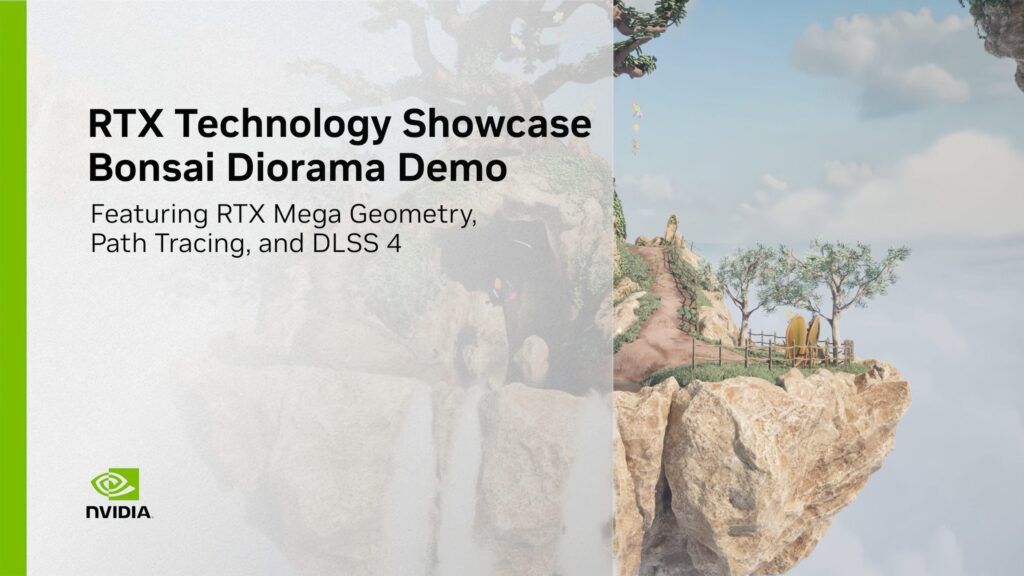
NVIDIA has launched an impressive new demo titled ‘Bonsai Diorama’ that highlights the capabilities of DLSS 4, path tracing, and RTX Mega Geometry. This release coincides with the latest update of the Unreal Engine RTX branch, version 5.6.1, which integrates RTX Mega Geometry with ReSTIR PT—recently enhanced for better performance and image quality—and the complete DLSS 4 suite.
The Bonsai Diorama demo requires a minimum of a GeForce RTX 2080Ti graphics card, though NVIDIA recommends a GeForce RTX 5060 for optimal performance. Users should ensure their systems are running GeForce driver 581.29 or newer to experience the demo’s full potential. Before diving into the demo, NVIDIA advises users to adjust resolution and window settings in the main menu. For those with an 8 GB GPU, starting at 1080p or 1440p is suggested, while 11 GB GPUs or higher can handle 4K resolution.
Once inside the demo, users can manage the interface by pressing ‘H’, allowing them to toggle RTX Mega Geometry and Ray Reconstruction, as well as adjust DLSS Super Resolution and Frame Generation settings. The standout feature of this demo is the RTX Mega Geometry, which made its debut in Remedy’s Alan Wake 2, showcasing significant performance improvements. However, NVIDIA’s current focus is on the image quality enhancements:
RTX Mega Geometry adds full quality Nanite geometry to the ray tracing bounding volume hierarchy (BVH), eliminating visual artifacts commonly seen with Unreal Engine 5’s default settings.
Technological Advancements and Developer Engagement
To further engage with developers, NVIDIA has scheduled a webinar on Thursday, October 28, at 10 AM Pacific Time. This session will provide an opportunity for developers to inquire about the Bonsai Diorama demo and its cutting-edge technologies.
In parallel, NVIDIA has announced that its Avatar Cloud Engine (ACE) can now leverage the open-source Qwen3-8B AI model as an In-Game Inferencing (IGI) SDK plug-in. This integration simplifies the developer’s workflow, optimizing the simultaneous processing of AI and graphics to enhance game performance. Qwen3 empowers developers to create game characters capable of real-time reasoning and dynamic responses to player actions and contextual scenarios.
Enhancements to NVIDIA’s Core Technologies
Alongside the Qwen3-8B release, NVIDIA has introduced several improvements to the core IGI SDK, including:
- MultiLORA adapters for rapid fine-tuning of model weights with minimal computational overhead.
- CUDA support for graphics with Vulkan backends, optimizing concurrent graphics and AI workloads for accelerated performance.
These advancements underline NVIDIA’s commitment to pushing the boundaries of gaming technology, providing developers with tools that enhance both visual fidelity and interactive capabilities.
Looking Ahead: The Impact of NVIDIA’s Innovations
The release of the Bonsai Diorama demo and the integration of Qwen3-8B into ACE represent significant strides in the gaming industry. By offering developers powerful tools to enhance both graphics and AI, NVIDIA is paving the way for more immersive and responsive gaming experiences. As these technologies continue to evolve, the potential for creating richer, more dynamic virtual worlds grows exponentially.
With continuous updates and community engagement, NVIDIA is not only setting new standards in gaming technology but also fostering an ecosystem where developers can thrive by leveraging cutting-edge innovations. The implications of these advancements are far-reaching, promising to redefine how games are developed and experienced in the future.







